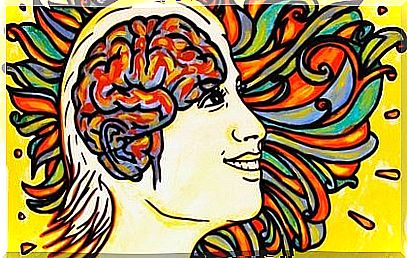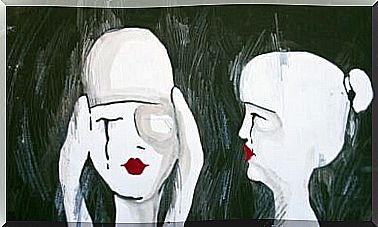Happiness Resides In The Left Hemisphere

The real focus of our feelings and emotions is not in the heart, but in the brain. Indeed, as recent studies reveal, happiness resides in the left hemisphere. When we feel enthusiastic, full of energy, positivity and hope, the area with the greatest neuroactivity is the left prefrontal cortex.
Daniel Goleman talked about it in a New York Times article explaining that in recent years neuroscience, psychology, Buddhism and spirituality are joining the strings to find answers to apparently distant disciplines. Let’s find out why happiness resides in the left hemisphere.
In this regard, a productive and rewarding meeting took place in May 2000 in which the Dalai Lama and the best neurologists and psychologists of the moment took part . The purpose of the meeting was to explain how Buddhism handles negative emotions, to find out what happens in the brain of a person accustomed to practicing meditation and using (apparently) a mental focus based on goodness, altruism and happiness.
The meeting lasted five days and took place in a secluded setting in Dharamsala, India. The meeting paid off, especially for one of the scientists, Dr. Richard Davidson, director of the Affective Neuroscience Laboratory at the University of Wisconsin, and author of books such as The emotional life of your brain. ). The man drew inspiration from the meeting to formulate a working hypothesis.
Happiness resides in the left hemisphere

Dr. Richardson is famous for his studies in the field of affective neuroscience. After years of work and analysis in his laboratory at the University of Wisconsin, the scientist repeats the same phrase in his lectures over and over: the basis of a healthy brain is goodness. Nowadays he presides over a research center on healthy minds in the same university and has got us used by now with his revelations.
In 2008, for example, he promoted a study with which he wanted to demonstrate the relationship between neuroplasticity and meditation techniques. People used to practicing meditation regularly (not valid if you started out of the blue), have greater electrical activity, greater ability to concentrate and a greater predisposition to learn and generate new neuronal connections.
On the other hand, if we look at his 2012 book The emotional life of your brain , we find some even more interesting theories. Among all, the one that claims that happiness resides in the left hemisphere of our brain. Let’s see it in detail.
The frontal lobes and our emotions
During the evolutionary phase of man as a species, the millions of neurons present in our brain have gradually specialized. Saying that happiness resides in the left hemisphere is nothing more than a way of expressing how and how our positive emotions have developed over time.
- Until recently, the idea was in force that the whole universe of feelings and emotions resided in the most primitive area of our inner brain, the one called “reptilian”. It is the area where more ancient structures are found such as the limbic system, which regulates emotional processes.
- Thanks to a discovery more than thirty years ago, neuroscience has revealed that emotions are not relegated to this area of the brain. The limbic system, in fact, is directly connected to the frontal lobes, involved in more complex thinking such as executive functions.

Anguish, stress and anxiety are found in the right hemisphere
Dr. Richard Davidson started from this very base. In fact, he was already aware of the relationship between the limbic system and the frontal lobes. After years of research and MRI testing, he came to a conclusion:
Functional MRI has revealed that when we experience distress, stress, or depression, the most active brain areas are the circuits that converge in the amygdala and right prefrontal cortex.
The right prefrontal cortex is linked to the hypervigilance stage, common at times when we experience high levels of stress.
The left hemisphere and positive emotions
Happiness resides in the left hemisphere, more precisely in the left frontal lobe. When we feel calm, optimistic, relaxed and confident, neuronal activity is less in the right frontal lobe and more intense in the left one.
This is an interesting fact, a reality that neuroscience now takes for granted and that can lead us to make a further reflection.
How to stimulate the left hemisphere
Dr. Davidson declares that the most valid way to modify brain activity is to improve our thoughts, our mental activity. This is supported by therapeutic approaches such as cognitive-behavioral therapy, used to treat depression, anxiety, phobias and stress.
If happiness resides in the left hemisphere and we wish to “silence” the hyperactivity of the right hemisphere, we should resort to the following dimensions:
- Meditation
- Goodness
- Altruism
- Rest
- Friendship
- Having a goal, a motivation
- Be enthusiastic
- Be positive and confident.

Regardless of where a certain process, quality or competence resides, we can modify and optimize our brain processes. We have an obligation to approach a more relaxed, open and flexible life line with which to establish the true neurological basis of happiness.









